
Horse teeth
Encyclopedia
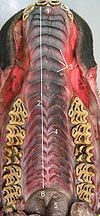
Types of teeth
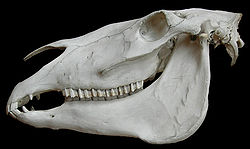
Horse
The horse is one of two extant subspecies of Equus ferus, or the wild horse. It is a single-hooved mammal belonging to the taxonomic family Equidae. The horse has evolved over the past 45 to 55 million years from a small multi-toed creature into the large, single-toed animal of today...
has between 36 and 44 teeth
Tooth
Teeth are small, calcified, whitish structures found in the jaws of many vertebrates that are used to break down food. Some animals, particularly carnivores, also use teeth for hunting or for defensive purposes. The roots of teeth are embedded in the Mandible bone or the Maxillary bone and are...
. All horses have
- Twelve premolarPremolarThe premolar teeth or bicuspids are transitional teeth located between the canine and molar teeth. In humans, there are two premolars per quadrant, making eight premolars total in the mouth. They have at least two cusps. Premolars can be considered as a 'transitional tooth' during chewing, or...
s and twelve molarMolar (tooth)Molars are the rearmost and most complicated kind of tooth in most mammals. In many mammals they grind food; hence the Latin name mola, "millstone"....
s commonly known as cheek teeth or jaw teeth. - Twelve incisorIncisorIncisors are the first kind of tooth in heterodont mammals. They are located in the premaxilla above and mandible below.-Function:...
s, or front teeth.
Additionally, a horse may have:
- Four or five canine teeth (tushes, tusks) between the molars and incisors. Generally all male horses have four canines. However, few female horses (less than 28%) have canines, and those that do usually have only one or two, which many times are only partially erupted.
- Between zero and four wolf teeth, which are vestigial premolars and not canines as the name may suggest. About 13-32% of all horses also are born with wolf teeth, with most of those having only one or two. They are equally common in male and female horses and much more likely to be on the upper jaw. If present these can cause problems in the bitting of the horse as they can interfere with the horse's bit contact, and may also make it difficult to rasp the second premolar. Therefore, wolf teeth are commonly removed.
Tooth growth

Fodder
Fodder or animal feed is any agricultural foodstuff used specifically to feed domesticated livestock such as cattle, goats, sheep, horses, chickens and pigs. Most animal feed is from plants but some is of animal origin...
ground up and soaked in water to create a soft mush for them to eat in order to obtain adequate nutrition
Equine nutrition
Equine nutrition is the feeding of horses, ponies, mules, donkeys, and other equines. Correct and balanced nutrition is a critical component of proper horse care....
. Commercially prepared hay
Hay
Hay is grass, legumes or other herbaceous plants that have been cut, dried, and stored for use as animal fodder, particularly for grazing livestock such as cattle, horses, goats, and sheep. Hay is also fed to pets such as rabbits and guinea pigs...
pellets and Hay cubes can be moistened for this purpose. Beet pulp
Beet pulp
Beet pulp is a byproduct from the processing of sugar beet which is used as fodder for horses and other livestock. It is supplied either as dried flakes or as compressed pellets, but when fed to horses it is usually soaked in water first.-Composition:...
may also be a suitable feed.
The teeth and the bit

Bridle
A bridle is a piece of equipment used to direct a horse. As defined in the Oxford English Dictionary, the "bridle" includes both the headstall that holds a bit that goes in the mouth of a horse, and the reins that are attached to the bit....
is not held between the horse's teeth, but lies in the "interdental space." This space lacks teeth, providing an area for the bit to rest without forcing the jaws open, and occurs between the cheek teeth and the incisors (or canines, should the horse have them).
However, if the bridle is adjusted so that the bit rests too low, or (more commonly) too high, it may push against the teeth and cause discomfort.
Sometimes, a "bit seat" is filed in the first cheek tooth. A veterinarian rounds the surface, so that, when the bit is pulled, the flesh of the cheek is not pushed into the sharp edge of the tooth. Although this practice is disputed, and most agree that an extreme bit seat can indeed be harmful, many veterinarians believe it makes riding more comfortable for the horse.
Estimating age using the teeth
It is possible to age a horse using signs of the tooth eruption and wear. However, this is not an exact science, and become increasingly difficult after the horse is "aged." Horses are individuals, and two horses of the same age may have different wear patterns.Estimating age using tooth eruption
There are 24 deciduous teethDeciduous teeth
Deciduous teeth, otherwise known as reborner teeth, baby teeth, temporary teeth and primary teeth, are the first set of teeth in the growth development of humans and many other mammals. In some Asian countries they are referred to as fall teeth as they will eventually fall out, while in almost all...
(also known as milk, temporary, or baby teeth). These come out in pairs, and are pushed out later by the permanent teeth. The number of permanent teeth may vary, depending on whether the horse has wolf teeth or canines. Most mares have 36, and most male horses have 40.
| Type of tooth | Number | Deciduous | Permanent |
|---|---|---|---|
| Incisor | First (central) | birth to 8 days | 2.5 yrs |
| Incisor | Second (intermediate) | 4.5–6 weeks | 3.5-4 yrs |
| Incisor | Third (corner) | 6–9 months | 4.5-5 yrs |
| Canine | Absent | 3.5-5 yrs, some around 6 yrs (if ever) | |
| Premolar | First (wolf) | Absent | 6 months to 3 years (if ever) |
| Premolar | Second | birth to 2 weeks | 2-3 yrs |
| Premolar | Third | birth to 2 weeks | 2.5-3 yrs |
| Premolar | Fourth | birth to 2 weeks | 3-4 yrs |
| Molar | First | Absent | 9–12 months |
| Molar | Second | Absent | 2 yrs |
| Molar | Third | Absent | 3-4 yrs |
By age five, all permanent teeth have usually erupted. The horse is then said to have a "full" mouth.
However, individual horses vary, and some breeds and types of horse are known to have differing eruption timelines. These include:
- Shetland poniesShetland ponyThe Shetland pony is a breed of pony originating in the Shetland Isles. Shetlands range in size from a minimum height of approximately 28 inches to an official maximum height of 42 inches at the withers. Shetland ponies have heavy coats, short legs and are considered quite intelligent...
: The middle and corner incisor (both deciduous and permanent) usually erupt later than the average horse. - Draft horseDraft horseA draft horse , draught horse or dray horse , less often called a work horse or heavy horse, is a large horse bred for hard, heavy tasks such as ploughing and farm labour...
s and miniature horseMiniature horseMiniature horses are found in many nations, particularly in Europe and the Americas. The designation of miniature horse is determined by the height of the animal, which, depending on the particular breed registry involved, is usually less than as measured at the last hairs of the mane, which are...
s: the permanent middle and corner incisors usually erupt later than average.
Estimating age using wear patterns
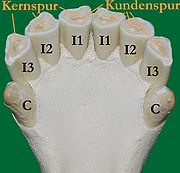
Cribbing (horse)
Cribbing or crib biting is a compulsive behavior or stereotypy seen in some horses, and considered a stable vice. It involves the horse grabbing a solid object such as the stall door or fence rail with its incisors, then arching its neck, pulling against the object, and sucking in air...
.
- Cups: are hollow and rectangular or oval in shape, appearing on the tables of the permanent incisors, that wear away over time. In general, cups are worn away on the lower central incisors by age 6, the lower intermediates by age 7, and corners at age 8. The cups of the upper central incisors are worn away by 9 years of age, the upper intermediate incisors by 10, and the corners by 11. When all the cups are gone, the horse is referred to as "smooth mouthed". In the past, dishonest dealers would "bishop" the teeth of old horses, usually by burning an indentation into the teeth, to imitate cups: but this practice was detectable by the absence of the white edge of enamel which always surrounds the real cup, by the shape of the teeth, and other marks of age about the animal.
- Pulp mark/Dental star: After some wear has occurred on the teeth, the central pulp cavity is exposed, and the tooth is marked by a "dental star" or "pulp mark" that is smaller than the incisor cups. These begin as a dark line in front of the dental cup, which grows in size and becomes more oval in shape as the cups are worn away. Dental stars are usually first visible at age 6, on the animal's lower central incisors, and very visible by age 8. They appear on the lower intermediates by age 9, and on the other incisors between the ages of 10–12 years.
- Hook/Notch: A hook appears on the upper corner incisor around age 7, and disappears by age 8. It reappears around age 13, again disappearing about 1 year later.
- Galvayne's Groove: The Galvayne's groove occurs on the upper corner incisor, producing a vertical line, and is helpful in approximating the age of older horses. It generally first appears at age 10, reaches half-way down the tooth by age 15, is completely down the tooth at age 20. It then begins to disappear, usually half-way gone by age 25, and completely gone by age 30.
- Lower jaw shape: Older horses may appear to have a lean, shallow lower jaw, as the roots of the teeth have begun to disappear. Younger horses may seem to have a lumpy jaw, due to the presence of permanent teeth within the jaw.
- Angle and Shape of the incisors: As the horse ages, the angle of the incisors generally becomes more acute, slanting forward. The incisors gradually change their form as the horse ages, becoming round, oval, and then triangular.
Dental problems

Problems due to wear patterns
Many dental problems in horses are related to the fact that their teeth erupt continuously throughout their life. Horses are evolved to graze nearly continuously, often on rough forage in semi-arid climates. Their teeth are designed to wear against the tooth above or below as the horse chews, thus preventing excess growth. The upper jaw is wider than the lower one. Sharp edges occur on the outside of the upper molars and the inside of the lower molars, as they are unopposed by an opposite grinding surface.There are many times when tooth wear is not even, and the horse may develop sharp edges on their teeth that reduce chewing efficiency of the teeth, interfere with jaw motion, and in extreme cases can cut the tongue or cheek, making eating and riding painful.
In the wild, natural foodstuffs may have allowed teeth to wear more evenly. Because many modern horses often graze on lusher, softer forage
Forage
Forage is plant material eaten by grazing livestock.Historically the term forage has meant only plants eaten by the animals directly as pasture, crop residue, or immature cereal crops, but it is also used more loosely to include similar plants cut for fodder and carried to the animals, especially...
than their ancestors, and are also frequently fed grain or other concentrated feed, it is possible some natural wear may be reduced in the domestic horse. On the other hand, this same uneven wear in the wild may have at times contributed to a shorter lifespan. Modern wild horses live an estimated 20 years at most, while a domesticated horse, depending on breed and management, quite often lives 25 to 30 years. Thus, because domesticated animals also live longer, they may simply have more time to develop dental issues that their wild forebears never faced.
Sharp enamel points usually develop on the outside of the upper cheekteeth (grinders) and the inside of the lower cheekteeth . "Hooks" also commonly occur on the front of the first upper cheekteeth (second upper premolars/#106/206), or at the posterior end of the last lower molars (distal #311/411).
A step mouth occurs when one cheek tooth grows longer than the others in that jaw. This is usually because the tooth opposing that particular one, located in the opposite jaw, was missing or broken, and therefore could not wear down its opponent.
A wave mouth occurs when at least two of the cheek teeth are higher than the others, so that, when viewed from the side, the grinding surfaces produce a wave-like pattern rather than a straight line. This can lead to periodontal disease and excessive wear of some of the teeth, eventually leading to some discomfort or trouble with mastication.
A shear mouth occurs when the grinding surfaces of the cheek teeth are severely sloped on each individual tooth (so the inner side of the teeth are much higher or lower than the outer side of the teeth). This may result in an angle at 60-75 degrees, opposed to the normal 15-degree angle seen on most horses. Again, the chewing motion is severely affected.
Bite problems
Horses may also experience an overbite/brachygnathismBrachygnathism
Brachygnathism or Parrot Mouth as it is often called, refers to uneven alignment of the upper and lower teeth. In serious cases, the upper teeth protrude beyond the lower teeth. Problem with parrot mouth occur if the molars at the back of the mouth are also uneven, resulting in large hooks forming...
(parrot mouth), or an underbite/prognathism
Prognathism
Prognathism is a term used to describe the positional relationship of the mandible and/or maxilla to the skeletal base where either of the jaws protrudes beyond a predetermined imaginary line in the coronal plane of the skull. In general dentistry, oral and maxillofacial surgery and orthodontics...
(sow mouth, monkey mouth). These may affect how the incisors wear. In severe cases, the horse's ability to graze may be affected. Horses also sometimes suffer from equine malocclusion
Equine malocclusion
An equine malocclusion is a misalignment between the upper and lower jaws of a horse or other equine. It results in a faulty bite with the upper and lower teeth failing to meet correctly.www.dictionary.com Malocclusions can cause pain to the horse and may also lead to weight loss and other eating...
where there is a misalignment between their upper and lower jaws.
The curvature of the incisors may also vary from the normal, straight bite. The curvature may be dorsal or ventral . These curvatures may be the result of an incisor malocclusion (e.g. ventral=overbite/dorsal=underbite). The curvature may also be diagonal, stemming from a wear pattern,offset incisors, or pain in the cheek teeth (rather than the incisors), which causes the horse to chew in one direction over the other.
Other dental problems
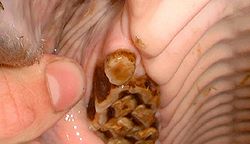
Signs of possible dental problems
- Reluctance to eat, does not finish food, or eats slowly
- Dull coat, weight loss, and loss of condition
- Quidding (horse drops partially chewed food while chewing), or chewing with the mouth open
- Turning of head to the side while chewing
- Excessive salivation while eating, blood in saliva
- Foul smell from mouth or nose
- Draining of abscess from the jaw
- Discharge from one nostril
- Undigested feed in manure
- Colic
- Excessive salivation
- Facial swelling
Additionally, many problems under saddle can be tooth-related, such as:
- head tossing
- difficulty in picking up the canterCanterThe canter is a controlled, three-beat gait performed by a horse. It is a natural gait possessed by all horses, faster than most horses' trot but slower than the gallop, and is used by all riders. The speed of the canter varies between 16-27 km/h , depending on the length of the stride of the horse...
or in performing flying changes - tilting of the head while riding or difficulty in bending
- refusal to collect
- buckingBuckingBucking is a movement performed by a horse or bull in which the animal lowers his head and raises his hindquarters into the air, usually while kicking out with his hind legs. If powerful, it may unseat the rider enough so that he falls off....
- difficulty in getting the horse "on-the-bit" (especially if the horse tends to go behind the bit)
- gaping the mouth
For many performance-related problems, it is often best to check the teeth to rule out that factor.
Prevention of dental problems
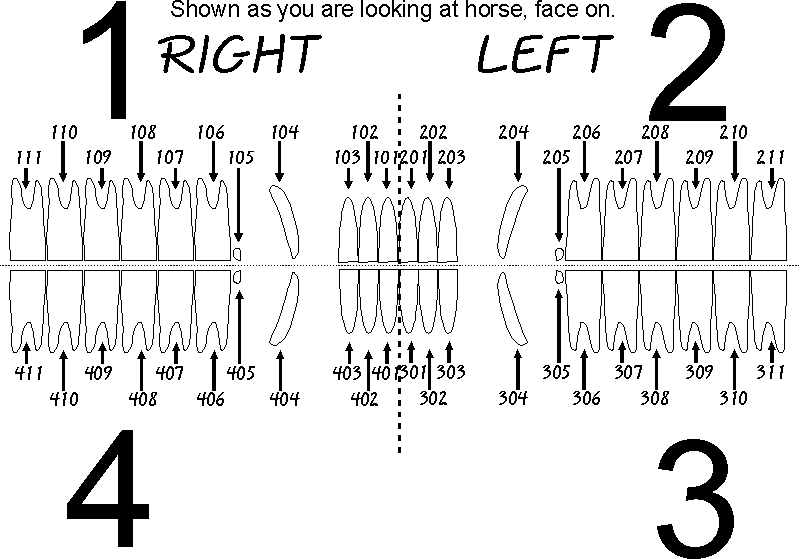
Many horses require floating (or rasping) of teeth once every 12 months, although this, too, is variable and dependent on the individual horse. In young horses, twenty four teeth are deciduous or "caps". These are the first three premolars of each arcade (not including wolf teeth) and all incisors. Caps are pushed out by the new permanent teeth, starting late in a horse's two year old year. Caps will eventually shed on their own, but may cause discomfort when still loose, requiring extraction. The first four or five years of a horse's life are when the most growth-related changes occur and hence frequent checkups may prevent problems from developing. Equine teeth get harder as the horse gets older and may not have rapid changes during the prime adult years of life, but as horses become aged, particularly from the late teens on, additional changes in incisor angle and other molar growth patterns often necessitate frequent care. Once a horse is in its late 20s or early 30s, molar loss becomes a concern. Floating involves a veterinarian wearing down the surface of the teeth, usually to remove sharp points or to balance out the mouth. However, the veterinarian must be careful not to take off too much of the surface, or there will not be enough roughened area on the tooth to allow it to properly tear apart food. Additionally, too much work on a tooth can cause thermal damage (which could lead to having to extract the tooth), or expose the sensitive interior of the tooth (pulp
Pulp (tooth)
The dental pulp is the part in the center of a tooth made up of living connective tissue and cells called odontoblasts.- Anatomy :Each person can have a total of up to 52 pulp organs, 32 in the permanent and 20 in the primary teeth....
). A person without a veterinary degree who performs this service is called a horse floater or equine dental technician.

